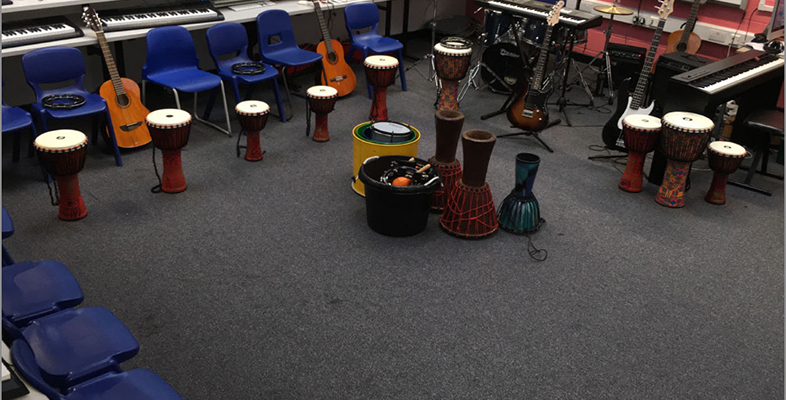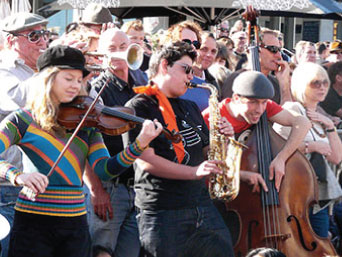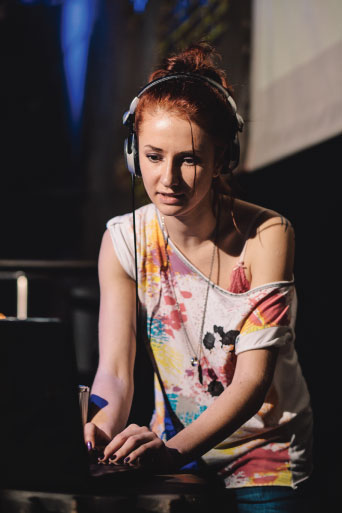1.2 What is musical teaching and learning?
A basic tenet for all music teachers is that everyone has the capacity to think and act musically and therefore everyone has the capacity to learn and be taught music. No one therefore should be labelled as ‘unmusical’. Indeed, in many cultures the idea that one can be ‘unmusical’ would be seen as absurd.
Young people demonstrate the capacity to be musical from a very young age. They experiment with their voices and take delight in exploring sound-making sources of all kinds. Young children also naturally ‘integrate’ music into their lives rather than seeing it as a separated activity, as described here by Shehan Campbell:
Children … demonstrated the natural connection between eating and socializing, making music, and moving. A glance down one table of first graders showed a wide array of polyrhythmic movement. One little girl was rotating her sandwich in a pulsing motion … in half circles in front of her. The next girl was tapping the bases of two carrots at top speed. On the other side of her, a boy was bouncing his milk carton in a syncopated beat. A girl was sucking a lollipop in a loud rhythm.
Activity 1
Watch this video clip in which the children demonstrate a similar relationship with music, integrating it into their play. Identify the different ways in which the children act musically and the kind of musical understandings they are demonstrating.
Transcript
Being outside means opportunities to climb, balance, be adventurous, be vigorous in an allowing space, coordinate movements with teammates and express joy noisily.
Being outside is about skipping and marching as you play the pipe. Exploring the dynamics of instruments without worrying about the noise, it's about sharing things.
Being outside is about experimenting novel ways of making sound, novel ways to be off the ground, and a novel place to have a chat.
Being outside is about swinging and twisting and weaving. Being outside is about concentrating in your own space; and a sense of balance, with a spring in your knees, until you can jump on to something fresh.
Both Shehan Campbell’s description and the video clip alert us to how musical behaviour and understanding is embodied – i.e. is demonstrated through the doing of music; through ‘acting musically’. What the children are doing in these examples is really no different from a concert violinist playing Beethoven’s violin concerto: both are demonstrating their musical knowledge and understanding through physically making and doing music. Musical understanding is embodied understanding. As Elliott writes, ‘The proof of my musicianship lies in the quality of my music making, in what I get done as a performer (improviser, composer, arranger, or conductor)’ (1995, p. 57).
There are, of course, many ways in which one might act musically. Daniel Levitin (2012) points out how within the areas of composing and performing there are many ways in which musical understanding might be demonstrated, often related to the musical tradition or style within which the performing and composing takes place. For example, whereas the classical music tradition sets much store by the capacity to use notation, in the majority of the world’s music the overarching skills are those of improvising and ‘playing by ear’.
Levitin also describes ways in which people are musical other than through playing an instrument and composing. He cites as examples people who demonstrate an ‘intense receptive sensitivity to music’ (2012, p. 634) by remaining deeply affected by music and the emotion it has engendered in them long after they have finished listening to it. He also notes how record producers and sound engineers often possess very highly developed receptive musical skills, yet many do not play an instrument or compose.
Then there are also those who have the auditory equivalent of a photographic memory – what Levitin calls a phonographic memory:
Some DJs can listen to the briefest excerpt of a musical piece, often 1 s or less, and identify the title, composer, and performers and distinguish several different performances of the same piece by the same group.
So, lots of ways in which ‘music teachers’ can support ‘musical learning’!
Activity 2
Part 1
Think about your own behaviours as a musician and note down the different ways in which you ‘act musically’. Which of these ways of acting musically have their roots in occasions where you were directly ‘taught music’ by a teacher in a classroom or music studio, and which did you acquire outside of these formal structures?
Part 2
Take one of these ways in which you act musically and plan a teaching activity for a key stage 3 class (ages 11–14) that would support them in acting in this way. Respond in detail, thinking about the resources you might use, how you might sequence the activity and the different musical experiences that the young people will engage in.


